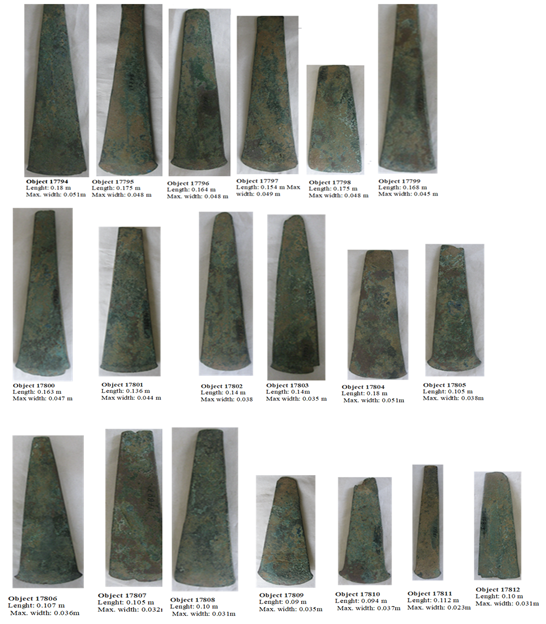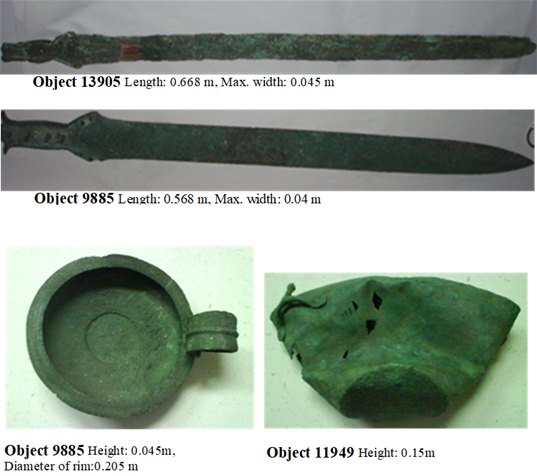The great archaeological and artistic value of historic copper-based artifacts from various archaeological sites of Greece results in the restriction or even the prohibition of sampling, settling the need for the employment of non-destructive testing (NDT) techniques. X-ray fluorescence (XRF), fiber optics diffuse reflectance spectroscopy (FORS) and scanning electron microscopy coupled with an energy dispersive X-ray detector (ESEM-EDX).
- XRF spectroscopy
- FORS
- ESEM-EDX
- arsenical copper
- tin bronze
- corrosion
- alloy composition
- Late Bronze Age
- Early Bronze Age
1. Overview
A multi-analytical non-destructive testing (NDT) methodology was applied to copper-based artifacts originated from various archaeological sites of Greece. X-ray fluorescence (XRF), fiber optics diffuse reflectance spectroscopy (FORS) and scanning electron microscopy coupled with an energy dispersive X-ray detector (ESEM-EDX) were used for the characterization of the alloys and the corrosion products. The key elements of the artifacts belonging to the Early Bronze Age (2700–2300 BC) were copper and arsenic, while tin bronze was used for the fabrication of the Late Bronze Age (1600–1100 BC) artifacts. The effectiveness of XRF for the determination of the bulk composition was confirmed by comparative study with the previously applied atomic absorption spectroscopy (AAS) and inductively coupled plasma–atomic emission spectrometry (ICP-AES) destructive techniques. Significant differences between the artifacts were revealed through the spectral measurement of their surface corrosion products color by FORS. ESEM-EDX provided information on the microstructure, the elemental composition of the corrosion layers and bulk, as well as the distribution of the corrosion products on the surface. Conclusively, the combined NDT methodology could be regarded as a valuable and appropriate tool for the elemental composition of the bulk alloy, thus leading to the classification of their historical period and the corrosion products, contributing significantly to their conservation–restoration.
2. NDT Methodology

Figure 1. 19 Chisels originated from Macedonia, Chalkidiki, Petralona, and dated at the Early Bronze Age (2700–2300 BC) —Nos. 17794–17812.

Figure 2. Nine copper-based objects (a saw, a double axe, daggers, swords, a razor, a spearhead and a bowl in fragments) originated from Euboea—the “Andronianoi hoard”—Nos. 10797, 10798, 10810–10816, dated back at the LBA (15th–12th century BC).

Figure 3. Copper-based Naue II swords of unknown provenance (Nos. 9885 and 13905), a bowl (No. 11934) and a large basin (No. 11949) from Peloponnese, Argolid, dated back at the LBA (14th–12th century BC).
3. Discussion
4. Conclusions
Archaeological copper-based artifacts of different historical periods and various origins were studied, via a multi-analytical NDT methodology including portable XRF and FORS. In addition to the former in situ techniques, ESEM-EDX, a laboratory technique, was used in a non-destructive manner, as the integrity of the fragment was not affected. The extensive use of arsenical copper alloys in Early Bronze Age was confirmed due to the determination of copper and arsenic elements by XRF analysis. On the contrary, tin bronze alloys prevailed in Late Bronze Age, as copper and tin were the main elements in the selected copper-based objects. Although XRF technique is performed on the surface, it is well-suited for the identification of the alloys, as the results are in good agreement with the elemental concentration values of previously applied AAS and ICP-AES techniques. Additionally, FORS technique indicates the spectral differences between the Early and the Late Bronze Age objects. ESEM-EDX analysis confirmed the reliability of XRF results and also enabled the differentiation of the surface corrosion products from the elemental composition of the bulk. Conclusively, the combined methodology XRF and FORS could be regarded as a valuable and appropriate non-destructive tool for the identification of the bulk alloy composition of historic copper-based objects, leading to their historical period classification and contributing significantly to their conservation–restoration. The additional application of ESEM-EDX, in case sampling is allowed, can integrate the results concerning the investigation of the corrosion products.References
- De Ryck, I.; Adriaens, A.; Adams, F. An overview of Mesopotamian bronze metallurgy during the 3rd millennium BC. J. Cult. Herit. 2005, 6, 261–268.
- Tylecote, R.F. A History of Metallurgy, 2nd ed.; Maney Materials Science: London, UK, 1992.
- Cheilakou, E. The Application of Spectroscopic and Non Destructive Testing & Evaluation Techniques (NDT&E) for the Materials Characterization, the Decay Inspection and the Conservation-Restoration of Historic Artefacts. Ph.D. Thesis, NTUA, School of Chemical Engineering, Materials Science and Engineering Section, Athens, Greece, 2011.
- Mangou, H.; Ioannou, P.V. On the chemical composition of Prehistoric Greek Copper-Based Artifacts from Mainland Greece. BSA 1999, 94, 81–100.
- Pernicka, E.; Begemann, F.; Sphmitt-Stecker, S.; Grimanis, A.P. On the composition of metal artifacts from Poliochni on Lemnos. Oxf. J. Archaeol. 1990, 9, 263–297.
- Mangou, H.; Ioannou, P.V. On the chemical composition of Prehistoric Greek Copper- Based Artifacts from the Aegean Region. BSA 1997, 92, 59–72.
- Mangou, H.; Ioannou, P.V. On the chemical composition of Prehistoric Greek Copper- Based Artifacts form Crete. BSA 1998, 93, 91–102.
- Stos-Gale, Z.; Sampson, A.; Mangou, E. Analyses of metal artifacts from the Early Helladic Cemetery of Manika on Euboia. Aegean Archaeol. 1996, 3, 49–62.
- Gilmore, R.G.; Ottaway, S.B. Micromethods for the Determination of Trace Elements in Copper-based Metal Artifacts. J. Archaeol. Sci. 1980, 7, 241–254.
- Mangou, H.; Ioannou, P.V. Studies of the Late Bronze Age copper-based ingots found in Greece. BSA 2000, 95, 207–217.
- Mangou, H.; Ioannou, P.V. Trends in the making of Greek copper-based artefacts during the prehistoric period (4000-1050 BC). OpAthRom 2002, 27, 105–118.
- Andreopoulou-Mangou, E. Chimiki analysi metallikon antikeimenon mykinaikis epochis apo tous Andronianous Evoias. EAM Mous. 2005, 5, 45–50. (In Greek)
- Grammenos, D.; Tzachili, I. O thesavros ton Petralonon this Chalkidikis. Archaeol. Ephemer. 1994, 85. (In Greek)
- Pernicka, E.; Begemann, F.; Schmitt-Strecker, S.; Todorova, H. KuleffI. Prehistoric copper in Bulgaria, its composition and provenance. Eurasia Antiq. 1997, 3, 41–180.
- Koui, M.; Papandreopoulos, P.; Andreopoulou-Mangou, E.; Papazoglou-Manioudaki, E.; Priftaj-Vevecka, A.; Stamati, F. Study of Bronze Age copper based swords of type Naue II and spearheads from Greece and Albania. Mediterr. Archaeol. Archaeom. 2006, 6, 5–22.
- Bourgarit, D.; Mille, B. The elemental analysis of ancient copper-based artefatcs by inductively-coupled-plasma atomic-emission spectrometry: An optimized methodology reveals some secrects of the Vix crater. Meas. Sci. Technol. 2003, 14, 1538–1555.
- Koui, M.; Andreopoulou-Mangou, E.; Papazoglou-Manioudaki, E.; Papandreopoulos, P. Preliminary results from the study of the composition ant the Manufacturing technique of Prehistoric Age copper objects from the Greek area. In Proceedings of the 2nd Greek Congress of Metal Materials, Athens, Greece, 25–26 November 2004; pp. 143–150. (In Greek).
- Mattsson, E.; Nord, A.G.; Tronner, K.; Fjaestad, M.; Laglerlof, A.; Ullen, I.; Borg, G.C. Deterioration of archaeological material in soil-Results on bronze artefacts. In Konserveringstekniska Studier; RIK 10; Riksantikvarieambetet: Stockholmm, Sweden, 1996; pp. 16–80.
- Robbiola, L.; Blengino, J.M.; Fiaud, C. Morphology and mechanisms of formation of natural patinas on archaeological Cu-Sn alloys. Corros. Sci. 1998, 40, 2083–2111.
- Geilmann, W. Verwitterung von Bronzen in Sandboden. Ein Beitrag zu Korrosionsforschung. Angew. Chem. 1956, 68, 201–211.
- Scott, A.D. Periodic corrosion phenomena in bronze antiquities. Stud. Conserv. 1985, 33, 49–57.
- Tylecote, R.F. The effect of soil conditions on the long-term corrosion of buried tin-bronzes and copper. J. Archaeol. Sci. 1979, 6, 345–368.
- De Ryck, I.; Pantos, E.; Adriaens, A. Near Eastern ancient bronze objects from Tell Beydar (NE- Syria): Insights into their corrosion. Eur. News 2007, 38, 29–33.
- Constantinides, I.; Adriaens, A.; Adams, F. Surface characterization of artificial corrosion layers on copper alloy reference materials. Appl. Surf. Sci. 2002, 189, 90–101.
- Saint, A.C.; Dritsa, V.; Cheilakou, E.; Koui, M. Non-invasive discrimination of early and late Bronze Age copper-based objects by means of XRF spectroscopy. In Proceedings of the 9th International Symposium on the Conservation of Monuments in the Mediterranean Basin, Ankara, Turkey, 3–5 June 2014; pp. 521–529.
- Craddock, P. The composition of the copper alloys used by Greek, Etruscan and Roman civilizations: The Greeks before the Archaic Period. J. Archaeol. Sci. 1976, 3, 93–113.
- Lechtman, H. Arsenic Bronze: Dirty Copper or Chosen Alloy? A View from the Americas. J. Field Archaeol. 1996, 23, 477–514.
- Bottaini, C.; Vilaça, R.; Montero-Ruiz, I.; Mirão, J.; Candeias, A. Archaeometric contribution to the interpretation of the Late Bronze Age “hoard” from Porto Do Concelho (Macão, Central Portugal). Mediterr. Archaeol. Archaeom. 2017, 17, 217–231.
- Cheilakou, E.; Koui, M. Corrosion products identification of simulated ancient copper alloys and Bronze Age copper based objects by Fiber Optics Diffuse Reflectance Spectroscopy technique (FODRS). In Proceedings of the XIII Balkan Mineral Processing Congress, Bucharest, Romania, 17–19 June 2009; Volume 1, pp. 79–86.
- Cheilakou, E.; Koui, M. Fiber Optics Diffuse Reflectance Spectroscopy (FODRS) as a tool for the non destructive characterization of ancient copper based artefacts through the measurement of their colour. In Proceedings of the 6th International Conference on Instrumental Methods of Analysis, Athens, Greece, 4–8 October 2009; p. 152.
- Scott, A.D. Copper and Bronze in Art. In Corrosion, Colorants, Conservation; Getty Publications, The Getty Consertion Institute: Los Angeles, CA, USA, 2002.
- De Ryck, I.; Adriaens, A.; Pantos, E.; Adams, F. A comparison of microbeam techniques for the analysis of corroded ancient bronze objects. Analyst 2003, 128, 1104–1109.
- Casaletto, M.P.; Ingo, G.M.; Albini, M.; Lapenna, A.; Pierige, I.; Riccucci, C.; Faraldi, F. An integrated analytical characterization of corrosion products on ornamental objects from the necropolis of Colle Badetta-Tortoreto (Teramo-Italy). Appl. Phys. A 2010, 100, 801–808.
- Ingo, G.M.; de Caro, T.; Riccucci, C.; Angelini, E.; Grassini, S.; Balbi, S.; Bernardini, P.; Salvi, D.; Bousselmi, L.; Çilingiroglu, A.; et al. Large scale investigation of chemical composition, structure and corrosion mechanism of bronze archeological artefacts from Mediterranean basin. Appl. Phys. A 2006, 83, 513–520.
- Oudbashi, O.; Emami, S.M.; Ahmadi, H.; Davami, P. Micro-stratigraphical investigation on corrosion layers in ancient Bronze artefacts by scanning electron microscopy energy dispersive spectrometry and optical microscopy. Herit. Sci. 2013, 1, 1–10.
- He, L.; Liang, J.; Zhao, X.; Jiang, B. Corrosion behavior and morphological features of archeological bronze coins from ancient China. Microchem. J. 2011, 99, 203–212.
- Arafat, A.; Na’es, M.; Kantarelou, V.; Haddada, N.; Giakoumaki, A.; Argyropoulos, V.; Anglos, D.; Karydas, A.G. Combined in situ micro-XRF, LIBS and SEM-EDS analysis of base metal and corrosion products for Islamic copper alloyed artefacts from Umm Qais museum, Jordan. J. Cult. Herit. 2013, 14, 261–269.
